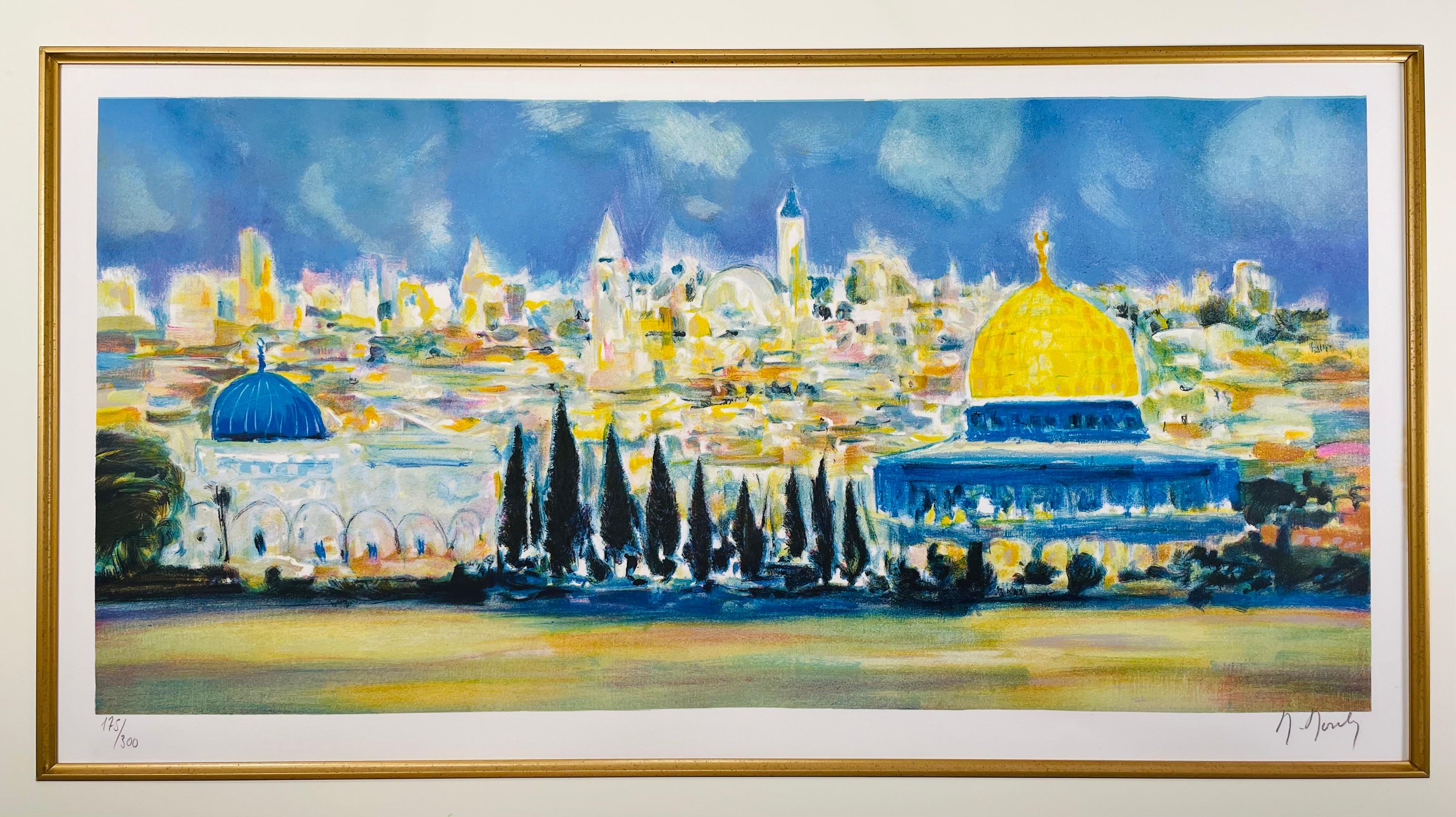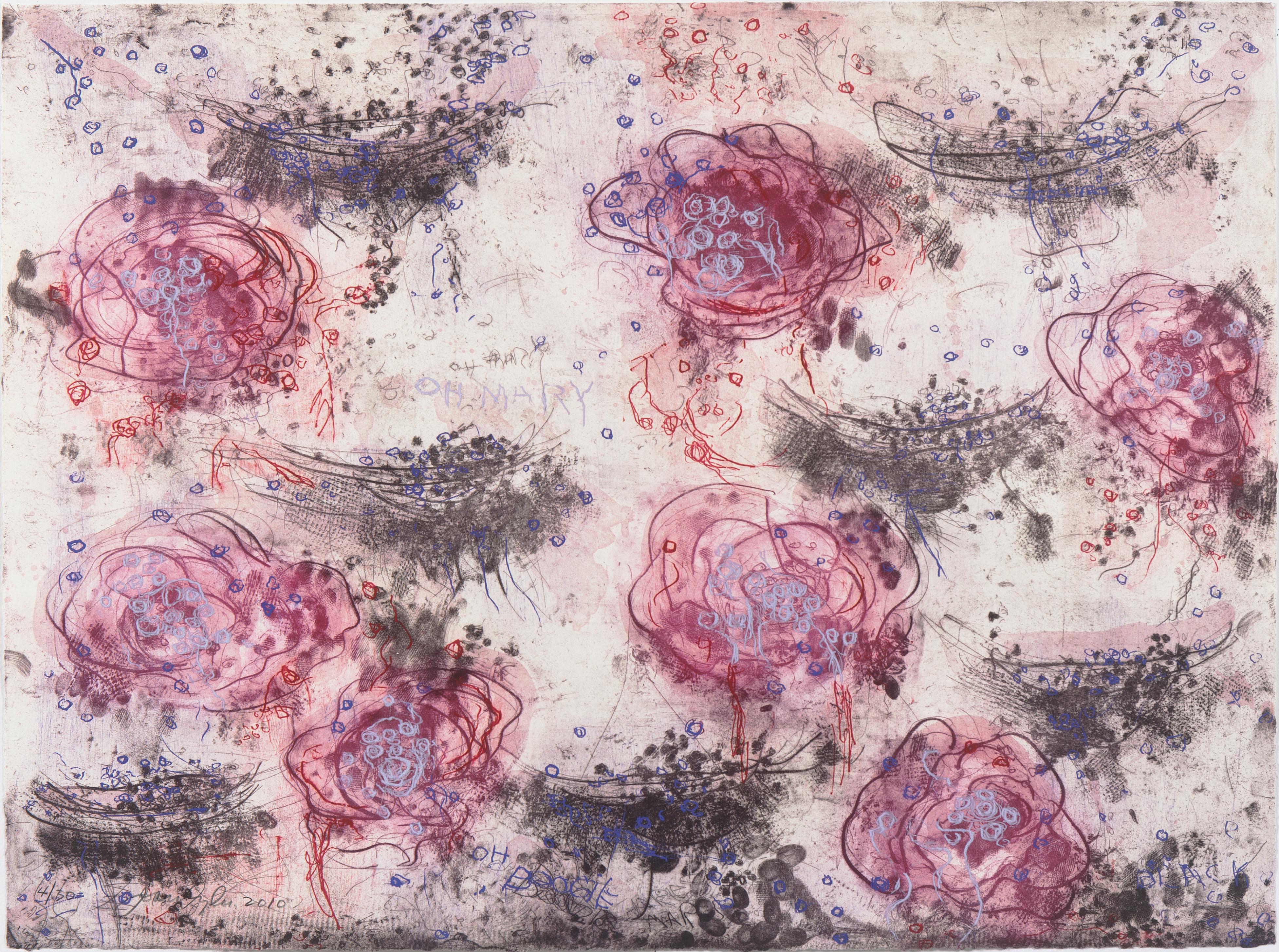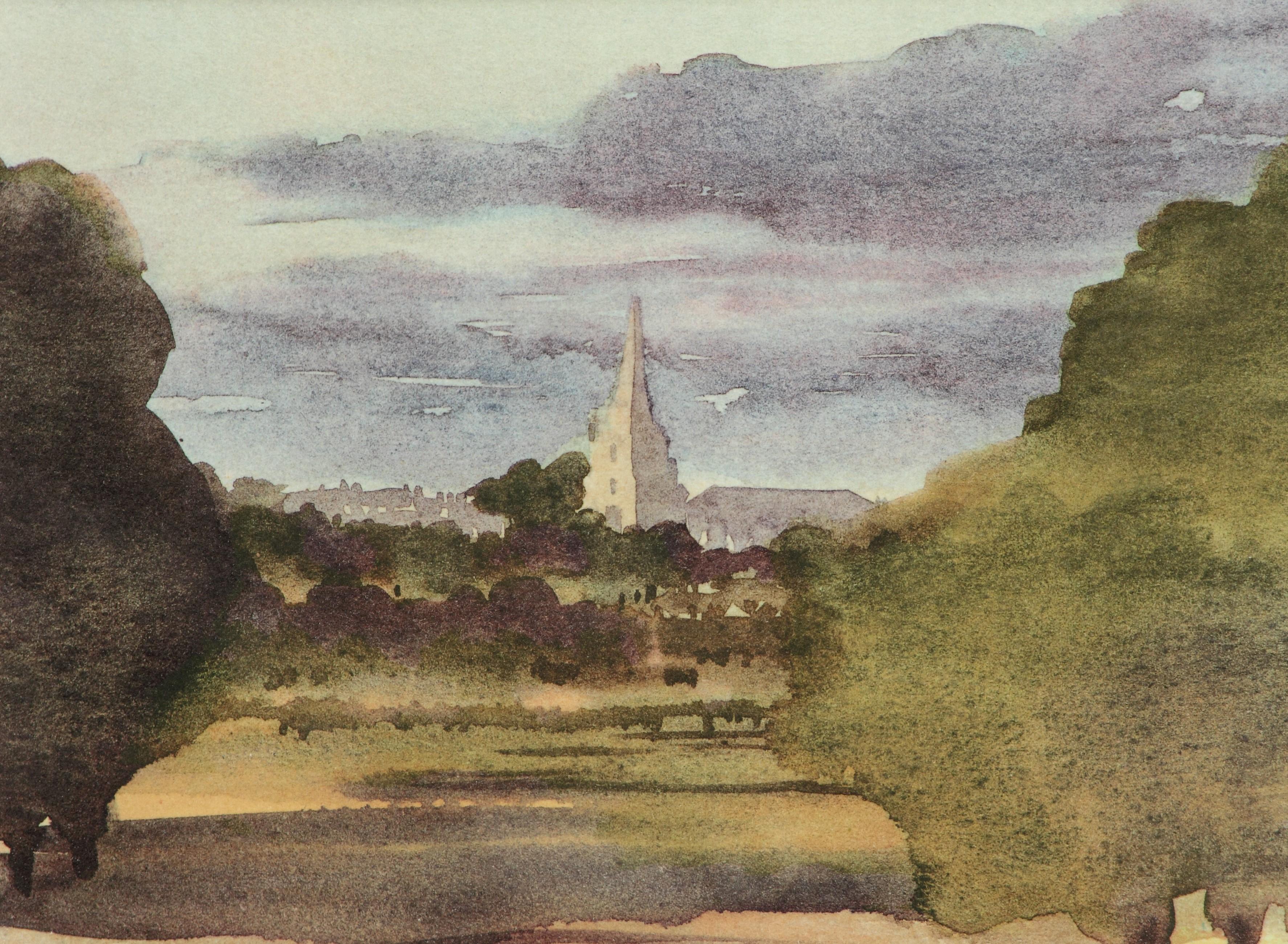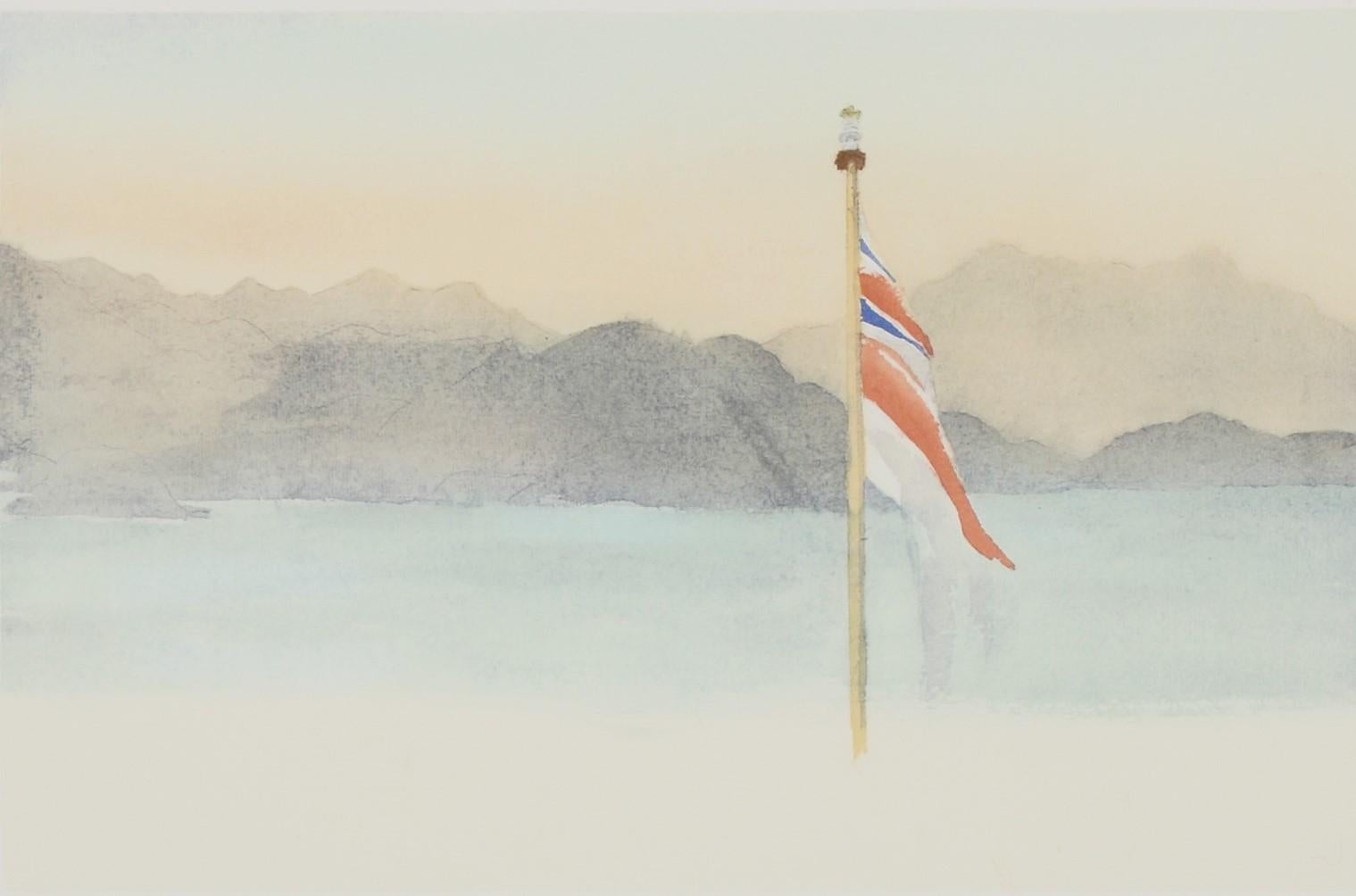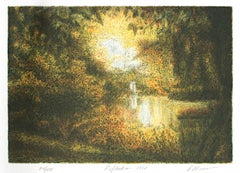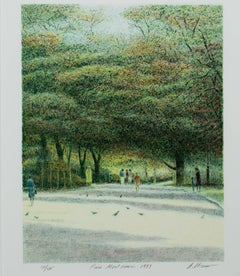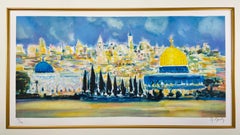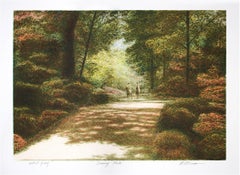
"Sunny Path, " Original Color Lithograph signed by Harold Altman
View Similar Items
Want more images or videos?
Request additional images or videos from the seller
1 of 9
Harold Altman"Sunny Path, " Original Color Lithograph signed by Harold Altman1998
1998
About the Item
- Creator:Harold Altman (1924 - 2003, American)
- Creation Year:1998
- Dimensions:Height: 18 in (45.72 cm)Width: 26 in (66.04 cm)
- Medium:
- Period:
- Condition:
- Gallery Location:Milwaukee, WI
- Reference Number:Seller: 9123c1stDibs: LU60532247393
About the Seller
4.9
Platinum Seller
These expertly vetted sellers are 1stDibs' most experienced sellers and are rated highest by our customers.
Established in 1966
1stDibs seller since 2017
388 sales on 1stDibs
Typical response time: 1 hour
More From This SellerView All
- "Reflection, " Original Color Lithograph signed by Harold AltmanBy Harold AltmanLocated in Milwaukee, WI"Reflection" is an original color lithograph by Harold Altman. The artist signed the piece in the lower right, titled and dated it lower center, and wrote the edition number (24/285)...Category
1990s Realist Landscape Prints
MaterialsLithograph
- "Parc Montsouris, " Original Color Lithograph Park View signed by Harold AltmanBy Harold AltmanLocated in Milwaukee, WI"Parc Montsouris" is an original color lithograph by Harold Altman. The artist signed the piece in the lower right, titled it lower center, and wrote the edition number (28/285) in t...Category
1990s Pointillist Landscape Prints
MaterialsLithograph
- "Quiet Afternoon, " Original Color Lithograph Classic Gift Spring ColorsBy Harold AltmanLocated in Milwaukee, WILeave it to artist Harold Altman to capture the beauty of nature as we delight in a "Quiet Afternoon". This work is an original color lithograph, number 28 out of an edition of 285, ...Category
21st Century and Contemporary Post-Modern Landscape Prints
MaterialsLithograph
- Sierra Madre - Lithographic PosterBy Carol SummersLocated in Milwaukee, WIThis is an offset lithograph poster signed by the artist Carol Summers. Based on his original woodcut that is of a much larger size.Category
1980s Landscape Prints
MaterialsLithograph
- "Deer Shooting in the Northern Woods, " Hand-colored LithographBy Currier & IvesLocated in Milwaukee, WI"Deer Shooting in the Northern Woods" is an original hand-colored lithograph by Currier & Ives. It depicts a landscape with a hunter aiming his gun at a deer on a winter day. 10" x 14" art 19 1/2" x 23 1/4" frame Nathaniel Currier was a tall introspective man with a melancholy nature. He could captivate people with his piercing stare or charm them with his sparkling blue eyes. Nathaniel was born in Roxbury, Massachusetts on March 27th, 1813, the second of four children. His parents, Nathaniel and Hannah Currier, were distant cousins who lived a humble yet spartan life. When Nathaniel was eight years old, tragedy struck. Nathaniel’s father unexpectedly passed away leaving Nathaniel and his eleven-year-old brother Lorenzo to provide for the family. In addition to their mother, Nathaniel and Lorenzo had to care for six-year-old sister Elizabeth and two-year-old brother Charles. Nathaniel worked a series of odd jobs to support the family, and at fifteen, he started what would become a life-long career when he apprenticed in the Boston lithography shop of William and John Pendleton. A Bavarian gentleman named Alois Senefelder invented lithography just 30 years prior to young Nat Currier’s apprenticeship. While under the employ of the brothers Pendleton, Nat was taught the art of lithography by the firm’s chief printer, a French national named Dubois, who brought the lithography trade to America. Lithography involves grinding a piece of limestone flat and smooth then drawing in mirror image on the stone with a special grease pencil. After the image is completed, the stone is etched with a solution of aqua fortis leaving the greased areas in slight relief. Water is then used to wet the stone and greased-ink is rolled onto the raised areas. Since grease and water do not mix, the greased-ink is repelled by the moisture on the stone and clings to the original grease pencil lines. The stone is then placed in a press and used as a printing block to impart black on white images to paper. In 1833, now twenty-years old and an accomplished lithographer, Nat Currier left Boston and moved to Philadelphia to do contract work for M.E.D. Brown, a noted engraver and printer. With the promise of good money, Currier hired on to help Brown prepare lithographic stones of scientific images for the American Journal of Sciences and Arts. When Nat completed the contract work in 1834, he traveled to New York City to work once again for his mentor John Pendleton, who was now operating his own shop located at 137 Broadway. Soon after the reunion, Pendleton expressed an interest in returning to Boston and offered to sell his print shop to Currier. Young Nat did not have the financial resources to buy the shop, but being the resourceful type he found another local printer by the name of Stodart. Together they bought Pendleton’s business. The firm ‘Currier & Stodart’ specialized in "job" printing. They produced many different types of printed items, most notably music manuscripts for local publishers. By 1835, Stodart was frustrated that the business was not making enough money and he ended the partnership, taking his investment with him. With little more than some lithographic stones, and a talent for his trade, twenty-two year old Nat Currier set up shop in a temporary office at 1 Wall Street in New York City. He named his new enterprise ‘N. Currier, Lithographer’ Nathaniel continued as a job printer and duplicated everything from music sheets to architectural plans. He experimented with portraits, disaster scenes and memorial prints, and any thing that he could sell to the public from tables in front of his shop. During 1835 he produced a disaster print Ruins of the Planter's Hotel, New Orleans, which fell at two O’clock on the Morning of the 15th of May 1835, burying 50 persons, 40 of whom Escaped with their Lives. The public had a thirst for newsworthy events, and newspapers of the day did not include pictures. By producing this print, Nat gave the public a new way to “see” the news. The print sold reasonably well, an important fact that was not lost on Currier. Nat met and married Eliza Farnsworth in 1840. He also produced a print that same year titled Awful Conflagration of the Steamboat Lexington in Long Island Sound on Monday Evening, January 18, 1840, by which melancholy occurrence over One Hundred Persons Perished. This print sold out very quickly, and Currier was approached by an enterprising publication who contracted him to print a single sheet addition of their paper, the New York Sun. This single page paper is presumed to be the first illustrated newspaper ever published. The success of the Lexington print launched his career nationally and put him in a position to finally lift his family up. In 1841, Nat and Eliza had their first child, a son they named Edward West Currier. That same year Nat hired his twenty-one year old brother Charles and taught him the lithography trade, he also hired his artistically inclined brother Lorenzo to travel out west and make sketches of the new frontier as material for future prints. Charles worked for the firm on and off over the years, and invented a new type of lithographic crayon which he patented and named the Crayola. Lorenzo continued selling sketches to Nat for the next few years. In 1843, Nat and Eliza had a daughter, Eliza West Currier, but tragedy struck in early 1847 when their young daughter died from a prolonged illness. Nat and Eliza were grief stricken, and Eliza, driven by despair, gave up on life and passed away just four months after her daughter’s death. The subject of Nat Currier’s artwork changed following the death of his wife and daughter, and he produced many memorial prints and sentimental prints during the late 1840s. The memorial prints generally depicted grief stricken families posed by gravestones (the stones were left blank so the purchasers could fill in the names of the dearly departed). The sentimental prints usually depicted idealized portraits of women and children, titled with popular Christian names of the day. Late in 1847, Nat Currier married Lura Ormsbee, a friend of the family. Lura was a self-sufficient woman, and she immediately set out to help Nat raise six-year-old Edward and get their house in order. In 1849, Lura delivered a son, Walter Black Currier, but fate dealt them a blow when young Walter died one year later. While Nat and Lura were grieving the loss of their new son, word came from San Francisco that Nat’s brother Lorenzo had also passed away from a brief illness. Nat sank deeper into his natural quiet melancholy. Friends stopped by to console the couple, and Lura began to set an extra place at their table for these unexpected guests. She continued this tradition throughout their lives. In 1852, Charles introduced a friend, James Merritt Ives, to Nat and suggested he hire him as a bookkeeper. Jim Ives was a native New Yorker born in 1824 and raised on the grounds of Bellevue Hospital where his father was employed as superintendent. Jim was a self-trained artist and professional bookkeeper. He was also a plump and jovial man, presenting the exact opposite image of his new boss. Jim Ives met Charles Currier through Caroline Clark, the object of Jim’s affection. Caroline’s sister Elizabeth was married to Charles, and Caroline was a close friend of the Currier family. Jim eventually proposed marriage to Caroline and solicited an introduction to Nat Currier, through Charles, in hopes of securing a more stable income to support his future wife. Ives quickly set out to improve and modernize his new employer’s bookkeeping methods. He reorganized the firm’s sizable inventory, and used his artistic skills to streamline the firm’s production methods. By 1857, Nathaniel had become so dependent on Jims’ skills and initiative that he offered him a full partnership in the firm and appointed him general manager. The two men chose the name ‘Currier & Ives’ for the new partnership, and became close friends. Currier & Ives produced their prints in a building at 33 Spruce Street where they occupied the third, fourth and fifth floors. The third floor was devoted to the hand operated printing presses that were built by Nat's cousin, Cyrus Currier, at his shop Cyrus Currier & Sons in Newark, NJ. The fourth floor found the artists, lithographers and the stone grinders at work. The fifth floor housed the coloring department, and was one of the earliest production lines in the country. The colorists were generally immigrant girls, mostly German, who came to America with some formal artistic training. Each colorist was responsible for adding a single color to a print. As a colorist finished applying their color, the print was passed down the line to the next colorist to add their color. The colorists worked from a master print displayed above their table, which showed where the proper colors were to be placed. At the end of the table was a touch up artist who checked the prints for quality, touching-in areas that may have been missed as it passed down the line. During the Civil War, demand for prints became so great that coloring stencils were developed to speed up production. Although most Currier & Ives prints were colored in house, some were sent out to contract artists. The rate Currier & Ives paid these artists for coloring work was one dollar per one hundred small folios (a penny a print) and one dollar per one dozen large folios. Currier & Ives also offered uncolored prints to dealers, with instructions (included on the price list) on how to 'prepare the prints for coloring.' In addition, schools could order uncolored prints from the firm’s catalogue to use in their painting classes. Nathaniel Currier and James Merritt Ives attracted a wide circle of friends during their years in business. Some of their more famous acquaintances included Horace Greeley, Phineas T. Barnum, and the outspoken abolitionists Rev. Henry Ward, and John Greenleaf Whittier (the latter being a cousin of Mr. Currier). Nat Currier and Jim Ives described their business as "Publishers of Cheap and Popular Pictures" and produced many categories of prints. These included Disaster Scenes, Sentimental Images, Sports, Humor, Hunting Scenes, Politics, Religion, City and Rural Scenes, Trains, Ships, Fire Fighters, Famous Race Horses, Historical Portraits, and just about any other topic that satisfied the general public's taste. In all, the firm produced in excess of 7500 different titles, totaling over one million prints produced from 1835 to 1907. Nat Currier retired in 1880, and signed over his share of the firm to his son Edward. Nat died eight years later at his summer home 'Lion’s Gate' in Amesbury, Massachusetts. Jim Ives remained active in the firm until his death in 1895, when his share of the firm passed to his eldest son, Chauncey. In 1902, faced will failing health from the ravages of Tuberculosis, Edward Currier sold his share of the firm to Chauncey Ives. In 1907, faced with competitive pressures from advancements in offset printing and photo engraving, Chauncey closed the venerable lithography business and sold the printing equipment and lithographic stones to his shop foreman, Daniel W. Logan. Nathaniel Currier and James Merritt Ives are laid to rest along with their families at the Greenwood Cemetery...Category
1860s Other Art Style Landscape Prints
MaterialsLithograph
- "Please, Mister, Don't Be Careless" Vintage Poster featuring Disney CharactersLocated in Milwaukee, WIPrinted in 1943, by the U.S. Government Printing Office for the U.S. Department of Agriculture Forest Service. The poster features the beloved Disney characters, Bambi (deer), Thumper (rabbit), and Flower (skunk) in wide-eyed shock leaning towards fear. With the slogan "Please, Mister, don't be careless" the poster is designed to tug at the heartstrings of the viewer and make them consider what actions they could take in their own lives to prevent forest fires. Poster: 20" x 14 1/4" Frame: 30" x 22 1/2" Framed to conservation standards with a 100% cotton fiber matboard border and UV clear glass that filters 99% of UV Rays. UV Rays can be especially damaging and cause fading to the inks used in poster making. All of these features are housed in a contemporary natural wood frame. Smokey Bear...Category
1940s Other Art Style Animal Prints
MaterialsLithograph
You May Also Like
- Architectural StudyBy Ettore SottsassLocated in Greding, DELarge format lithograph with architectural study, partly coloured. Signed at lower right. Edition 65/100(?).Category
Late 20th Century Post-Modern Landscape Prints
MaterialsLithograph
Price Upon Request - Trees and Fields, Print Club of ClevelandBy Peter TakalLocated in Berlin, MD“Trees and Fields” lithograph commissioned for the Print Club of Cleveland by Peter Takal Peter Takal’s original lithograph “Trees and Fields” is an accomplished work of art created in 1957. This lithograph bears the stamp “The Print Club of Cleveland” on verso. This impression is signed by Takal in pencil. “Trees and Fields” is a fine example of the art created by the 20th century Romanian / German / American artist, Peter Takal. Peter Takal: Born in Romania in 1905, Peter Takal spent most of his youth in Berlin and was mainly self-taught. His first one-man exhibition took place in the Gurlitt Gallery, Berlin, in 1932. During the following seven years his art was frequently exhibited at galleries in Berlin, Munich, Paris and as well as Casablanca and Algiers. At the beginning of the Second World War (1939), Peter Takal came to the United States for an exhibition of his art at the Katherine Kuhe Gallery, Chicago. He decided to remain in the United States and became an American citizen in 1944. Living in New York, Peter Takal quickly established himself as a leading printmaker and a modern master of both lithography and drypoint engraving. One-man exhibitions of his art took place in New York City (1942), Chicago (1939 & 1941), Washington (1959) and Los Angeles (1966). International exhibitions of his art were held at the Galeria de Arte Mexicano, Mexico City (1959), the Palazzo Strozzi, Florence, Italy (1960) and at the Kestner-Museum in Germany (1962). Museums to date that include Peter Takal's original prints in their collections are, the Chicago Art Institute, the Library of Congress, Washington, the Los Angeles County Museum of Art, the United States State Department, UCLA, the Berlin National Museum and the Bibliotheque Nationale, Paris. Over the years, the Museum of Modern Art in New York and the Arkansas Arts Center have acquired a very extensive collection of Peter Takal's lithographs and drypoints. The artist died in 1995. The Print Club of Cleveland: The Print Club of Cleveland is a non-profit adjunct organization and the country's first museum-affiliated print club devoted to the promotion of art and printmaking as a fine art for printmakers and collectors alike. With its creation in 1919, it has helped to support the growth of the department of prints and drawings at the Cleveland Museum of Fine Arts and has also been a source of great enrichment for collectors of fine prints. During the organizations long history, the club has annually commissioned one original etching engraving, lithograph, woodcut and or other form of original graphic art from such fine American artists as John Taylor Arms, Suzanne Anker, Luigi Lucioni, Will Barnet, Mark Tobey, Lyonel Feininger, Henry George Keller, Louis Lozowick, Karl Schrag, David Jansheski, Deborah Remington, and Peter Takal, as well as from leading international artists such as Henri Matisse, Edmund Blampied, Jean-Emile Laboureur, Salvador Dali, Michael di Cerbo, Phyliss Sloane, Paolo Boni, Juvenal Sanso...Category
Mid-20th Century Hudson River School Landscape Prints
MaterialsLithograph
- Jerusalem Marcel MoulyBy Marcel MoulyLocated in Berlin, MDMarcel Mouly (French 1918 - 2008) “Jerusalem” lithograph on woven paper with deep saturated colors in excellent condition. Well framed with acr...Category
Mid-20th Century Abstract Landscape Prints
MaterialsLithograph
- Wild RosesBy Joan SnyderLocated in Brooklyn, NYWild Roses, 2010 Lithograph/etching/woodcut 28 3/8 × 38 3/8 in 72.1 × 97.5 cm This print combines etching, lithography, and woodcut to create a great variet...Category
2010s Contemporary Landscape Prints
MaterialsEtching, Lithograph, Woodcut
- Bird's Eye View Of The Great Suspension BridgeLocated in New York, NYBird's Eye View Of The Great Suspension Bridge Print on paper Description: The Brooklyn Bridge was a cultural phenomenon when it was first built, inspiring artists, entrepreneurs, ...Category
1880s Naturalistic Landscape Prints
MaterialsLithograph
- Jean Banham. 'The Embankment, The Thames , London' Lithograph C1960'sLocated in Frome, SomersetFine print from the 1960's London. Embackment in London, by the Thames. City side with Houses of Parliamant looking west. Fine piece of history. Banham made many works of Central London...Category
1960s Contemporary Landscape Prints
MaterialsLithograph
$455 Sale Price20% Off


